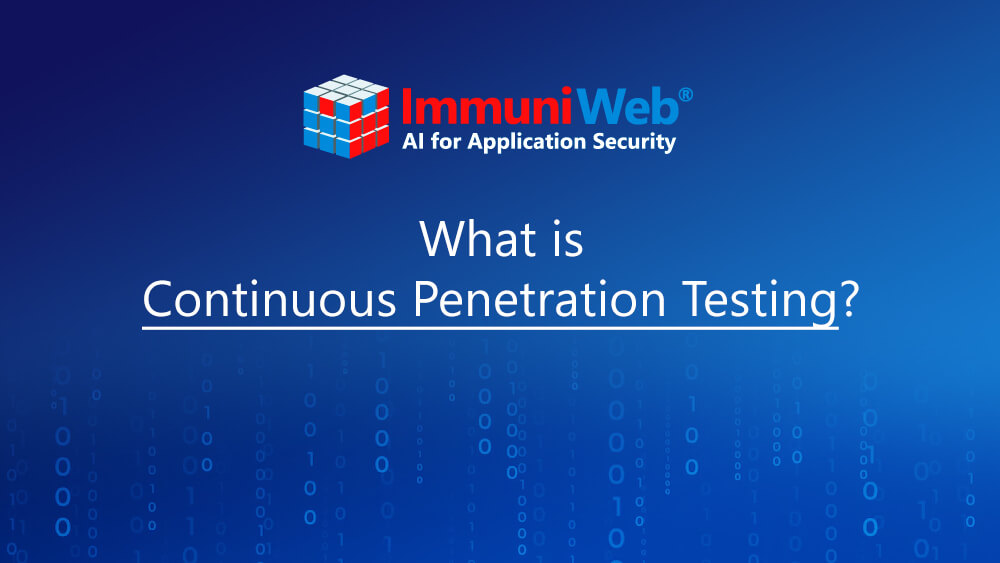What is Continuous Penetration Testing?
Continuous Penetration Testing (CPT) is a cybersecurity methodology that involves regularly testing
an organization's systems and applications for vulnerabilities.

Unlike traditional penetration testing, which is typically performed on a periodic basis, CPT takes a more proactive approach by continuously monitoring for new vulnerabilities and conducting tests as they are discovered. This helps to ensure that an organization's security posture is always up-to-date and that it is protected against the latest threats.
Outperform traditional penetration testing with 24/7 continuous penetration testing by ImmuniWeb® Continuous Penetration Testing offering.
Benefits of Continuous Penetration Testing
- Reduced risk of data breaches: By identifying and remediating vulnerabilities as soon as they are discovered, CPT helps to minimize the risk of data breaches.
- Improved compliance: CPT can help organizations to comply with industry regulations and internal security policies by ensuring that their systems and applications are always secure.
- Enhanced security posture: CPT continuously monitors for new vulnerabilities, providing organizations with a proactive approach to security.
- Reduced costs: CPT can help to reduce the costs associated with security incidents by identifying and remediating vulnerabilities before they can be exploited.
Stages of Continuous Penetration Testing
- Discovery: The first stage of CPT involves identifying the organization's assets and understanding their vulnerabilities. This is typically done by gathering data from various sources, such as vulnerability scanners, network traffic logs, and configuration management databases.
- Exploitation: The second stage of CPT involves attempting to exploit the vulnerabilities that have been identified. This is done using automated tools and manual penetration testing techniques.
- Reporting: The final stage of CPT involves reporting on the results of the testing. This report should include a detailed analysis of the vulnerabilities that were found, as well as recommendations for remediation.
- Vulnerability scanners: These tools automate the process of identifying vulnerabilities in systems and applications.
- Penetration testing frameworks: These frameworks provide a structured approach to penetration testing, including tools for vulnerability assessment, exploitation, and reporting.
- Security information and event management (SIEM) systems: These systems collect and analyze security data from various sources, which can be used to identify and track vulnerabilities.
- Frequency: CPT is conducted on a continuous basis, while traditional penetration testing is typically performed on a periodic basis.
- Scope: CPT can cover a wider range of assets and vulnerabilities than traditional penetration testing.
- Automation: CPT often utilizes automated tools, while traditional penetration testing may be more manual.
- Developing a security policy: This policy should outline the organization's approach to CPT, including the frequency of testing, the scope of testing, and the tools that will be used.
- Selecting a vendor: There are a number of vendors that offer CPT solutions. The organization should select a vendor that has the experience and expertise to meet its specific needs.
- Training staff: Security staff should be trained on the CPT process and the tools that will be used.
- Monitoring and reporting: It is important to continuously monitor the results of CPT and report on the findings to senior management.
- Learn more about Continuous Penetration Testing.
- See the benefits of our Partner Program.
- Read our Cyber Law and Cybercrime Investigation blog.
- Follow ImmuniWeb on LinkedIn, X (Twitter), and Telegram.
- Subscribe to our Newsletter.
Tools for Continuous Penetration Testing
There are a number of tools that can be used for CPT. These tools can be classified into three main categories:
Continuous Penetration Testing vs Traditional Penetration Testing
Continuous penetration testing is different from traditional penetration testing in a number of ways:
Implementing Continuous Penetration Testing
Implementing CPT requires a number of steps, including:
Conclusion
Continuous Penetration Testing is a valuable tool for organizations that are serious about protecting their security posture. By regularly testing for vulnerabilities and taking action to remediate them, organizations can minimize the risk of data breaches and other security incidents.

